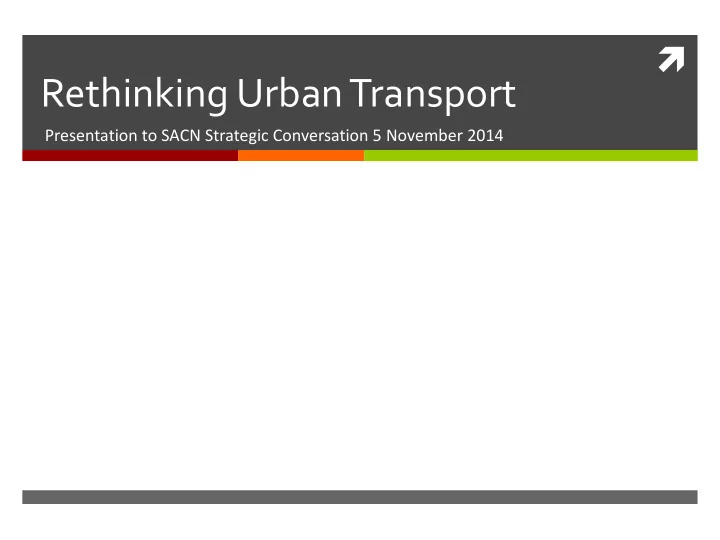

Rethinking Urban Transport Presentation to SACN Strategic Conversation 5 November 2014
Summary Reduce cost of urban transport Complete public Reinforce PT Enable walking Help people out transport networks by and cycling at of private motor networks quickly spatial scale car and efficiently interventions Invest in cost Work with Leverage ICT to Embrace minibus reducing emerging shifts create new taxi industry infrastructure in nature of work flexible transport not subsidies and lifestyle options
1. High cost of urban transport Cost of passenger transport (public and private) in SA metros is very high by international standards SA has longest daily commutes of 40 countries surveyed (OECD 2012) In 2005/06 transport accounted for 20.8 percent of total annual household consumption expenditure in urban areas (Stats SA 2008) More than 50% of poor urban residents spend more than 20% of their declared household income for transport (Kane 2010) % of GGP allocated to passenger transport (public and private) in SA metros higher than in any other region (over 23%) – ( Public and private expenditure on public transport in 6 metros – R 26,2 bn per year (50% on MBTs) Massive drag on economy, on people especially poor, on public finances
Cost of urban transport 25 Private Public 20 15 10 5 0 Source: UITP (in PVR/RH 2014)
Reinforcing shift to private car Modal Modal % Change share 2003 share 2013 Public Train 7,1% 6,6% -0,5% Transport Bus 7,5% 6,2% -1,3% Taxi 22,5% 25,1% 2,6% Total 37,1% 37,9% 0,8% Private Car 28,5% 34,2% 5,8% Transport Walk 32,3% 25,8% -6,5% Other 2,2% 2,0% -0,1% Total 62,9% 62,1% -0,8% Source : NHTS 2013
Key strategic question Key assessment frame for How do we public transport and related spatial interventions reduce overall (importance of modelling) cost of urban Cost comparisons need to include costs of externalities transport? and spillovers and should include lifecycle costing
2. Complete public transport networks Core idea of PTSAP (2007) – Integrated Rapid Public Transport Networks : “85% of residents within 1 km of IRPTN by 2020” Conundrum Complete functioning integrated network key to reducing costs Not enough money available to finance completion of comprehensive network infrastructure or the associated on-going operations Solutions: Tightly focus public investments in BRT and rail services on key urban corridors rather than being comprehensive Use minibus bus taxi as non-subsidised modes to fill gaps – responsive to the dispersed demand patterns of low-density urban form Enhance simple inter-modality On-going incremental improvements – many small things more than few big things
3. Embrace minibus taxi industry Recognise MTB as backbone of urban passenger transport – the default Regulatory dysfunction and low innovation have limited potential of industry to evolve – safety, service quality, profitability but strong economic logic for industry evolution Shift of regulatory role to cities combined with development of transport ICT technologies has potential to catalyse major change to ensure safer, more efficient, more integrated and better quality MTB services
4. Support networks through spatial interventions Origin Destination – – – – Source : van Ryneveld and Hunter 2014
5. Focus on cost-reducing investments not subsidies Grant 2014/15 Recurring operating subsidies such as PTOG can perpetuate spatial PTOG R 4,83 bn inefficiencies and marginalisation PTISG R 4,97 bn E.g In Tshwane, over R 1 bn PTNOG R 0,9 bn per year spent on moving passengers average of 55 km Total grants R 27,06 bn + per trip E.g. Modelling shows massive impact on bottom line of dedicated lanes for buses and MBTs Importance of holistic non-silo approaches (single integrated metro grant?)
6. Enable walking and cycling at scale From To Flowering of walking and Walking and cycling as cycling unsafe and inconvenient last resort Powered by massive community works type programme to proliferate pathways and provide on-going security Incentives (enabled by smart devices) through fund from transport investment reductions and carbon offsets
7. Work with emerging shifts in work and lifestyle “End of full - time job”, mass unemployment and telecommuting changes mobility needs – connecting and work spaces close to home Café’ as new office On-line shopping & rise of local logistics Smartphone replacing car as enabler of independence
8. Help people out of private motor car Pricing strategies - congestion and targeted fuel taxes, distance-based insurance and registration fees, targeted parking pricing Incentives for multi-passenger private vehicles Privileging public transport over private car New roads restriction
9. Leverage ICT to create new flexible transport options – meta-network and new mobility Car pooling and car sharing Aggregating taxis using DRS Multi-modal route planning Information and choice
Summary Reduce cost of urban transport Complete public Reinforce PT Enable walking Help people out transport networks by and cycling at of private motor networks quickly spatial scale car and efficiently interventions Invest in cost Work with Leverage ICT to Embrace minibus reducing emerging shifts create new taxi industry infrastructure in nature of work flexible transport not subsidies and lifestyle options
Recommend
More recommend